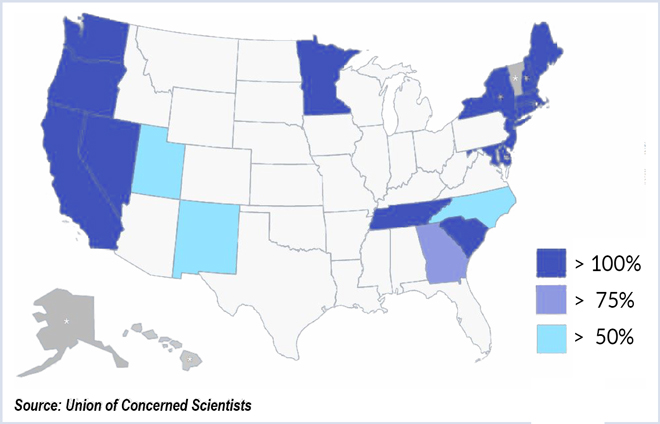By William Opalka
When the Clean Power Plan was released last year, New York’s grid operator was concerned with its impact despite the state’s membership in a regional carbon trading regime.
Reliance on coal generation had threated reliability, in the view of NYISO, so changes needed to be made, even though New York had cut emissions by 39% from 2000 levels. (See NYISO: EPA Clean Power Plan Threatens Reliability for New York City.)
Changes made in the final plan based on input from grid operators — combined with a more pronounced shift toward gas generation and renewables in New York as new power plants move closer to completion and the state has committed another $1.5 billion for clean energy over the next decade — seem to have allayed those fears.
“Based on our initial review, it appears EPA responded positively to major concerns regarding reliability in the draft rule, and that the final rule is generally favorable to New York,” NYISO spokesman David Flanagan said.
EPA also added a reliability safety valve and a requirement that states seek grid operators’ reliability assessments on their implementation plans.
“A reliability safety valve will allow a state to propose a modified emission standard for an affected generator for a temporary period of time to address an unforeseen emergency situation that threatens reliability,” Flanagan said.
In June, the state committed to reducing all greenhouse gas emissions by 40% from 1990 levels, cutting energy consumption in buildings by 23% from 2012 levels and getting half of the state’s energy from renewable sources.
While New York is ahead of most other states, it will have to make decisions on retirements of aging, fossil fuel plants and the future of the Indian Point nuclear facility.
New England
The New England states — members of the Regional Greenhouse Gas Initiative, along with New York — are generally well ahead of the targets set in the Clean Power Plan, in some cases by several years. EPA has recognized RGGI as a model compliance tool.
Connecticut, Massachusetts and New Hampshire have less stringent goals for the 2022 interim period, reflecting what EPA calls a “smoother glide path.” However, those states have more stringent goals by 2030 compared to other states.
Connecticut’s interim goal is 899 lbs/MWh and its 2030 goal is 786 lbs/MWh; Massachusetts is at 956 and 824, respectively; Rhode Island, 877 and 771; and New Hampshire comes in at 1,006 and 858.
Maine no longer has any of the coal-burning power plants considered the primary target of the emissions reductions. Under the goals, Maine would have to reduce its carbon dioxide emissions per megawatt-hour of electricity by 10.8% by the year 2030.
Vermont is one of three states, along with Alaska and Hawaii, exempted from the rules. Vermont’s largest source of electricity is hydropower imported from Canada. The Green Mountain State has some in-state dams and two wood-burning power generators.
The Union of Concerned Scientists issued a report last week that said the Northeast states are among 20 states that have made commitments (including carbon caps, coal plant closures and mandatory renewable electricity and energy efficiency standards) that put them more than halfway toward meeting their 2030 targets. Sixteen states are likely to surpass the targets, the group said.


